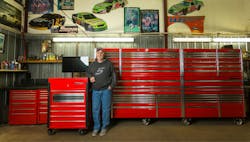As a second-generation technician, Gerald Dahlin has been around cars since the late '70s and early '80s. Growing up in his father’s shop, he helped with cleanup and organization as a kid. After graduating from a technical college and taking his ASE certifications to become a master technician, he partnered with his father in 1989 to open up D.A.D.'s Repair. When his father retired around 13 years ago, Dahlin took over as owner and operator.
Now, with three ASE-certified technicians working for him, Dahlin’s day-to-day looks a little different from when he was just a technician, but that hasn’t lessened the importance of a sturdy, reliable toolbox for him.
Mr. Big
In 1987, as a senior in high school, Dahlin bought his first Snap-on toolbox. It was the largest that Snap-on sold at the time and came in red, the same color his father always chose for his own toolboxes. Since then, he’s gone through a number of boxes, from a KRL 1003 in 2003 to his current toolbox, the Mr. Big he traded for in 2015. Through it all, he’s remained steadfast in his preference for red.
“It’s always got to be red, or I don’t want it,” says Dahlin.
The only exception to this specific aesthetic rule is the second Mr. Big toolbox at the front counter of his shop -- a white box with blue detailing that matches Dahlin’s high school car.
Keeping it tidy
To make room for the 12’ long red Mr. Big toolbox, Dahlin decided to cut his workbench to fit only the toolbox and no additional add-ons or accessories. The best part of the box, according to Dahlin, is the ease with which he’s able to organize his tools. Being able to open the drawer and immediately find the tools he needs without moving or shuffling things around is essential for Dahlin’s workflow.
When it comes to organizing his tools, Dahlin typically keeps the more commonly used tools in drawers that are about waist high. Things like screwdrivers, pliers, and combination wrenches go in separate drawers. For metric and standard size tools, he keeps things easy and puts standard to the left side and metric to the right side of the drawer.
Choosing a toolbox
Something that Dahlin advises technicians to consider when purchasing a toolbox is the quality and structure of the product.
“You can charge whatever you want to charge,” Dahlin says. “But the way the drawers pull out, [their] strength, I think that’s the most important thing to look at or inform someone about before purchasing a toolbox.”
As for the future of his Mr. Big setup, Dahlin plans on calling it quits when his toolbox does.
“I told my Snap-on dealer this is the last one. If this one fills up, I’m retiring,” Dahlin laughs.
About the Author
Elli Carder
Assistant Editor | PTEN & Professional Distributor
Elli Carder is an assistant editor for Endeavor Business Media's Vehicle Repair Group. With a background in professional and creative writing, Carder helps edit for both Professional Tools and Equipment News (PTEN) and Professional Distributor magazines, as well as VehicleServicePros.com.

